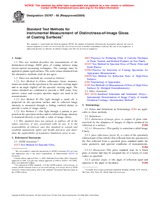We need your consent to use the individual data so that you can see information about your interests, among other things. Click "OK" to give your consent.
ASTM D5767-95(2004)
Standard Test Methods for Instrumental Measurement of Distinctness-of-Image Gloss of Coating Surfaces
STANDARD published on 1.11.2004
The information about the standard:
Designation standards: ASTM D5767-95(2004)
Note: WITHDRAWN
Publication date standards: 1.11.2004
SKU: NS-32453
The number of pages: 6
Approximate weight : 18 g (0.04 lbs)
Country: American technical standard
Category: Technical standards ASTM
Annotation of standard text ASTM D5767-95(2004) :
Keywords:
distinctness of image, gloss, high gloss surfaces, image clarity, ICS Number Code 25.220.01 (Surface treatment and coating in general)
Additional information
| Significance and Use | ||||||||||||||||
|
An important aspect of the appearance of glossy coating surfaces is the distinctness (clarity) of images reflected by them. The values obtained by the measuring procedures given in these methods generally correlate well with visual ratings for DOI (image clarity).4 Although Test Methods D 523 and D 4039 are useful in characterizing some aspects of glossy appearance, they do not provide satisfactory ratings for DOI (image clarity). The measurement conditions given conform to the conditions specified in Test Methods E 430. The measurement conditions given in Test Methods B and C conform to the conditions specified in ISO Standard #10216. The scale values obtained with the measuring procedures of these methods range from 0 to 100 with a value of 100 representing perfect DOI (image clarity). The DOI (image clarity) scale value does not of itself, indicate any specific cause for reduction in reflected image sharpness. Surface irregularities such as haze, orange peel, and wrinkle, when present, may be cited as causes for reduction of image sharpness. |
||||||||||||||||
| 1. Scope | ||||||||||||||||
|
1.1 This test method describes the measurement of the distinctness-of-image (DOI) gloss of coating surfaces using electro-optical measuring techniques. The coatings must be applied to planar rigid surfaces. The scale values obtained from the alternative methods cited do not agree. 1.2 Three test methods are covered as follows: 1.2.1 Test Method AGloss reflectance factor measurements are made on the specimen at the specular viewing angle and at an angle slightly off the specular viewing angle. The values obtained are combined to provide a DOI value. Very narrow source and receptor aperture angles are used in the measurements. 1.2.2 Test Method BThe light through a small slit is projected on the specimen surface and its reflected image intensity is measured through a sliding combed shutter to provide a value of image clarity. 1.2.3 Test Method CThe light through a pattern is projected on the specimen surface and its reflected image intensity is measured directly to provide a value of image clarity. 1.3 This standard does not purport to address all of the safety concerns, if any, associated with its use. It is the responsibility of whoever uses this standard to consult and establish appropriate safety and health practices and determine the applicability of regulatory limitations prior to use. |
||||||||||||||||
| 2. Referenced Documents | ||||||||||||||||
|
We recommend:
Updating of laws
Do you want to be sure about the validity of used regulations?
We offer you a solution so that you could use valid and updated legislative regulations.
Would you like to get more information? Look at this page.




 Cookies
Cookies
